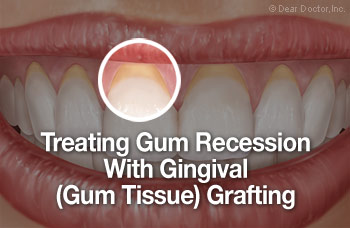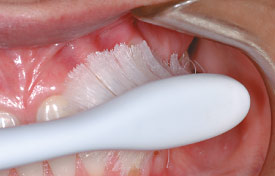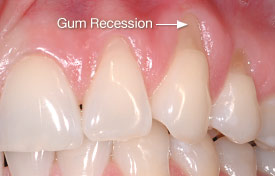Periodontal Plastic Surgery
Treating Gum Recession With Gingival (Gum Tissue) Grafting

Millions of Americans have some degree of gum recession, but what exactly is gum recession, why is it problematic, and how can it be treated?
Gum recession describes a loss of the pink gum tissue that surrounds teeth, leading to exposure of the root surfaces of a tooth or teeth. Besides being unsightly, recession can disturb the relationship of the surrounding gum tissues to the teeth, affecting both structure and function, and resulting in anything from minor tooth sensitivity to tooth loss in very severe cases.
Gum or “gingival” tissue, as it is medically known, is supposed to encircle and firmly attach to the necks of the teeth and the underlying bone, forming a barrier known as “attached gingiva.” It is described as a “wear and tear” tissue, which is resistant to the abrasive action of foods during eating, biting and chewing. Similar tissue is found on the surfaces of the tongue and hard palate (roof of the mouth).
 |
| Brushing too hard splays the toothbrush bristles causing abrasion of the gum tissues, which results in recession. |
 |
|
| Overzealous brushing can cause damage to teeth and gums. Note that the gums have receded and the roots, which are now showing, are also being abraded. | |
| Photos provided by Dr. Edward Allen | |
Recession — The Thick And Thin Of It
There is a lot of normal variation in human physical characteristics that is inherited, which means it is genetically determined. This genetic variation gives rise to different biological forms or types referred to as “bio-types.” There are two basic gum tissue biotypes, thick and thin, with a great deal of variation in between. Broadly speaking, thick and thin tissues tend to respond differently to both trauma and disease.
Thin gum tissue biotypes are more prone to recede than thick ones, but recession tends to be caused or aggravated by a combination of other factors:
- Ineffective oral hygiene — inadequate removal of dental bacterial plaque (biofilm).
- Excessive brushing (and flossing) — too hard, or for too long.
- Mal-positioned and/or prominent teeth that are not fully encased in supporting bone are therefore pre-disposed to gum recession.
- Muscle attachments (frenums) pulling at the gum line.
- Habits — holding foreign objects between the teeth, such as nails that press on the gum tissues.
- Appliances — badly fitting removable partial dentures and orthodontic appliances (braces), tongue bolts, etc., can impinge upon gum tissues causing recession.
In addition, recession is accompanied by loss of some or all the protective zone of attached gingival tissue.
Signs And Symptoms of Gum Recession
Root surfaces exposed by gum recession can become sensitive to temperature and pressure changes, and can also decay or wear away. Exposed roots don't look too appealing, either. Fortunately, recession is treatable.
An important treatment consideration is whether the recession is stable or progressive. For example, a 70-year-old might have isolated or generalized gum recession, but still have adequate zones of attached protective gum tissue. In this case, if the exposed root surfaces are healthy, there may not be reason to do anything but monitor the situation. On the other hand, a teenager with a history of fairly rapid gum recession (over a period of months) usually requires early intervention and treatment.



